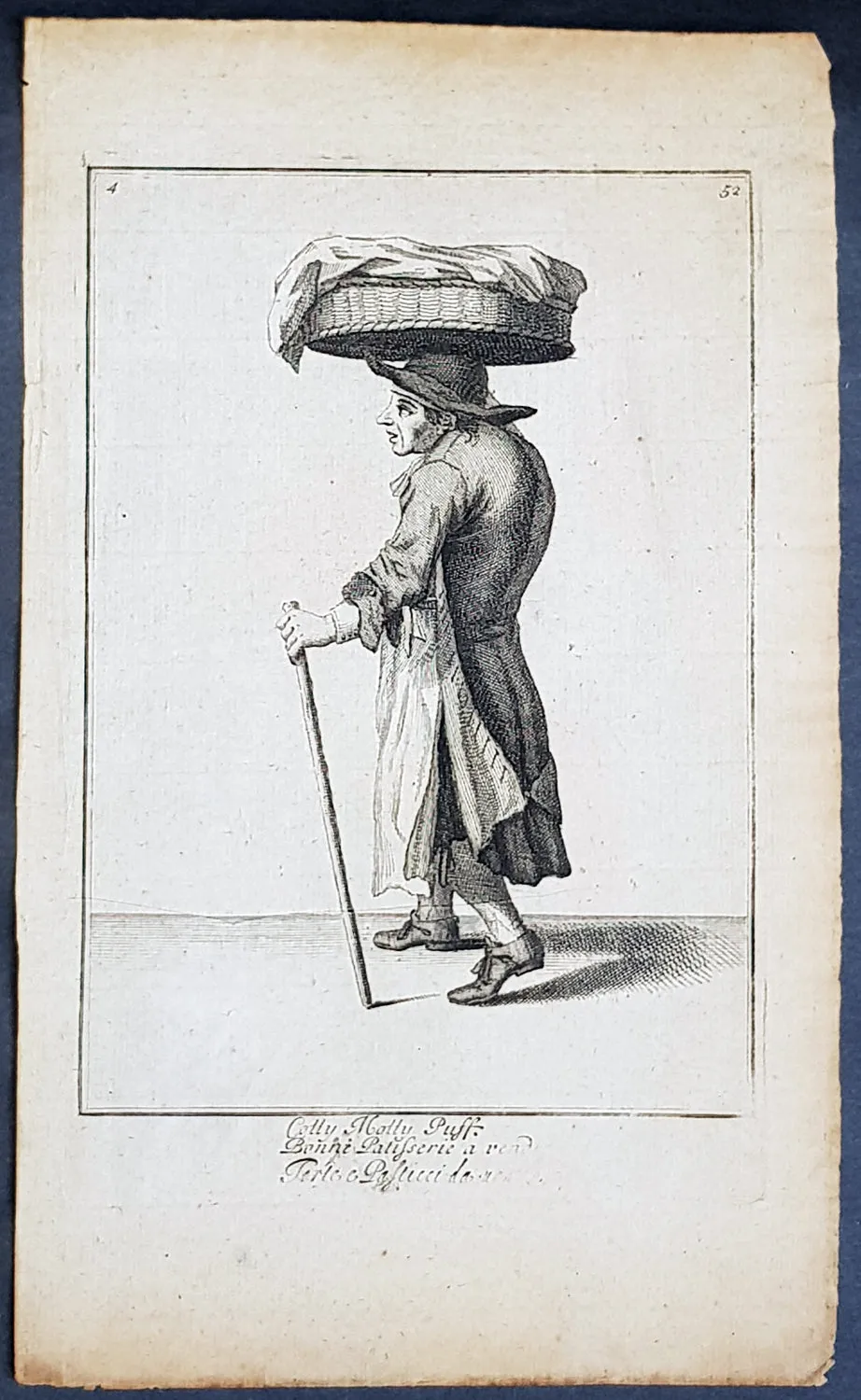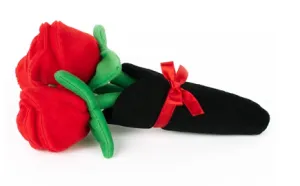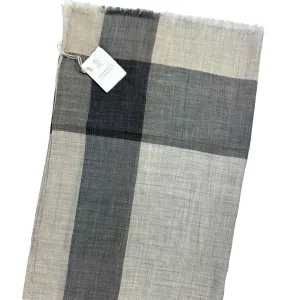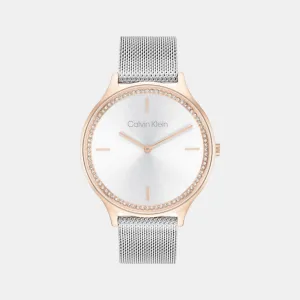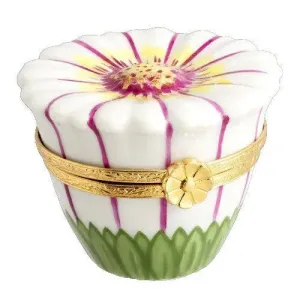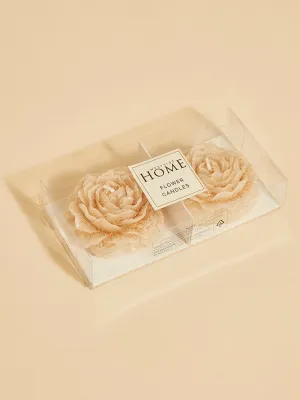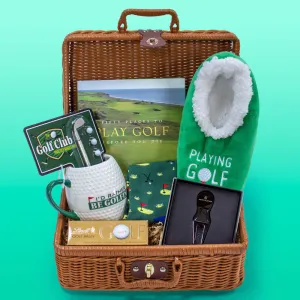- Title : Colly Molly Puff; Bonne Patisserie a Vendre; Torte e Pasticci
- Date : 1687
- Ref: 20722
- Size: 13in x 8in (330mm x 205mm)
Description:
This original copper-plate engraved rare antique print of Colly Molly Puff , a well know street hawker known to Marcellus Laroon in Covent Garden - was engraved by John Savage for the first 1687 edition of Marcellus Laroons The Cryes of the City of London, Drawne after the Life published by Pierce Tempest, London.
Originally there were 40 prints designed for the first edition that was quickly expanded to 74, this one of Colly Molly Puff was included in the original 40. This original print is printed on laid heavy paper.
General Definitions:
Paper thickness and quality: - Heavy and stable
Paper color : - off white
Age of map color: -
Colors used: -
General color appearance: -
Paper size: - 13in x 8in (330mm x 205mm)
Plate size: - 13in x 8in (330mm x 205mm)
Margins: - Min 1/2in (12mm)
Imperfections:
Margins: - Age toning
Plate area: - Age toning
Verso: - Age toning
Background:
Samuel Pepys and Daniel Defoe both owned copies of Marcellus Laroons The Cryes of the City of London, Drawne after the Life. Among the very first Cries to be credited to an individual artist, Laroons Cryes of the City of London Drawne after the Life were on a larger scale than had been attempted before, which allowed for more sophisticated use of composition and greater detail in costume. For the first time, hawkers were portrayed as individuals not merely representative stereotypes, each with a distinctive personality revealed through their movement, their attitudes, their postures, their gestures, their clothing and the special things they sold. Marcellus Laroons Cries possessed more life than any that had gone before, reflecting the dynamic renaissance of the City at the end of the seventeenth century.
Previous Cries had been published with figures arranged in a grid upon a single page, but Laroon gave each subject their own page, thereby elevating the status of the prints as worthy of seperate frames. And such was their success among the bibliophiles of London, that Laroons original set of forty designs commissioned by the entrepreneurial bookseller Pierce Tempest in 1687 was quickly expanded to seventy-four and continued to be reprinted from the same plates until 1821. Living in Covent Garden from 1675, Laroon sketched his likenesses from life, drawing those he had come to know through his twelve years of residence there, and Pepys annotated eighteen of his copies of the prints with the names of those personalities of seventeenth century London street life that he recognised.
There is an appealing egalitarianism to Laroons work in which each individual is permitted their own space and dignity. With an unsentimental balance of stylisation and realism, all the figures are presented with grace and poise, even if they are wretched. Laroons designs were ink drawings produced under commission to the bookseller and consequently he achieved little personal reward or success from the exploitation of his creations, earning his living by painting the drapery for those more famous than he and then dying of consumption in Richmond at the age of forty-nine. But through widening the range of subjects of the Cries to include all social classes and well as preachers, beggars and performers, Marcellus Laroon left us us an exuberant and sympathetic vision of the range and multiplicity of human life that comprised the populace of London in his day.
John Savage (active 1683–1701) was an engraver and printseller in London. Savage was said to be French, and therefore may have been a Huguenot exile. He resided in Denmark Court, The Strand, until he purchased the plates and took over the business of Isaac Beckett at the Golden Head in the Old Bailey. Later he moved to the Golden Head in St. Paul\'s Churchyard, a hub of the publishing and printmaking industry near Doctors\' Commons.
Savage produced book illustrations and portraits which he published as frontispieces or separately, as well as playing and trade cards, and from 1683 he was the engraver of the plates for the Philosophical Transactions of the Royal Society. Though he had bought Beckett\'s stock of mezzotint plates and continued to offer mezzotints, the plates he produced himself were only etchings and engravings.
Savage etched plates of Marcellus Laroon\'s Cries of London for the publisher Pierce Tempest. Only two – The Merry Fiddler and The London Quaker – bear Savages signature but Antony Griffiths, the former Keeper of the Department of Prints and Drawings at the British Museum, attributes all 72 of the series to him.
Laroon, Marcellus 1653 - 1702
Marcellus Laroon was a Dutch-born painter and engraver, active in England. He provided the drawings for the popular series of prints The Cries of London.
He was born at The Hague, the son of Marcellus Lauron, a painter of French extraction who settled in the Netherlands. He began his artistic education with his father, who took him to be taken to England at an early age. According to brief biographies by Horace Walpole and Bainbrigg Buckeridge he was taught by one La Zoon before studying under one of the Flessiers, a family of Dutch painters and framemakers working in London in the mid-17th century.
He spent several years in Yorkshire and later told George Vertue that he had seen Rembrandt at Kingston upon Hull in 1661. He had settled in London by 1674, the year in which he became a member of the Painter-Stainers Company. He lived in Bow Street, Covent Garden. He was frequently employed to paint draperies for Sir Godfrey Kneller, and was well known as a copyist.
Laroon became known for small portraits and conversation pieces. He also painted small pictures, on humorous or free subjects, in the style of Egbert van Heemskerk, some of which were engraved in mezzotint by Isaac Beckett and John Smith. He also made some etchings and mezzotints on similar subjects himself. Buckeridge said of his painting.... When he came to work for himself, he made it his endeavour to follow nature very close, so that his manner was wholly his own. He was a general Painter, and imitated other masters hands exactly well. He painted well, both in great and little, and was an exact draftsman; but he was chiefly famous for drapery, wherein he exceeded most of his cotemporaries...
Laroon is best known for the drawings he made of The Cryes of London which were engraved by John Savage, and published by Pierce Tempest. He also drew the illustrations for The Art of Defence, a fencing manual by William Elder published in 1699 and the procession at the coronation of William III and Mary in 1689. He painted portraits of Queen Mary (engraved in mezzotint by Robert Williams), Caius Gabriel Cibber the sculptor, and others. Some drawings by him entered the collection of the British Museum.
He married the daughter of Jeremiah Keene, a builder, of Little Sutton, near Chiswick, by whom he had a large family, including three sons, who were brought up in his profession.
He died of consumption at Richmond, Surrey on 11 March 1702, and was buried there. He left a collection of pictures, which was sold by auction by his son Marcellus Laroon the Younger on 24 February 1725.




